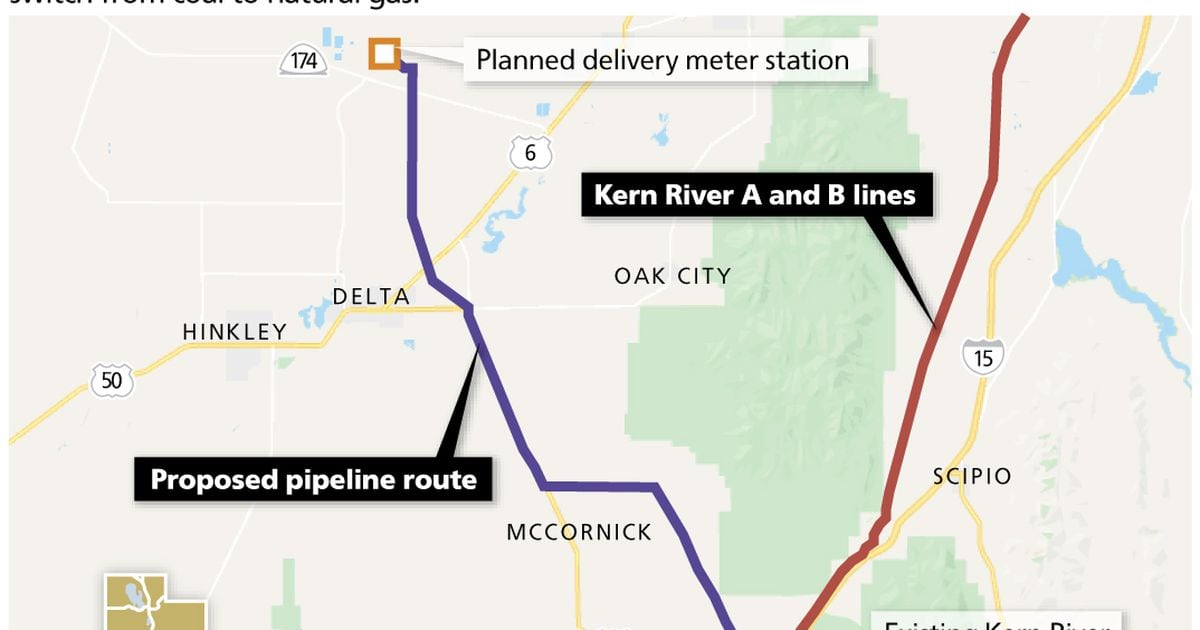
Plans are underway to run a pipeline across 36 miles of private and public rangeland in Millard County to connect the coal-fired Intermountain Power Project (IPP) with an interstate natural gas line. The proposal is needed to accommodate the Utah power-generating station’s conversion to hydrogen and natural gas, slated to occur by 2025 at the behest of the Southern California cities that use the power.
The Delta Lateral Project is proposed by the Kern River Gas Transmission Co., which operates an interstate network of pipelines that tie Wyoming’s gas-producing regions with markets in Utah and other Western States.
According to an environmental impact statement (EIS) released this month by the Federal Energy Regulatory Commission, or FERC, the firm seeks to construct a 36-mile lateral line from a tie-in at Holden to the power plant north of Delta. The 24-inch-diameter line would be buried under a 50-foot-wide right of way.
FERC is accepting public comment on the plan through Dec. 27.
The environmental review of the right of way is coming at a delicate juncture in IPP’s move away from coal, which is troubling some rural Utah lawmakers and Millard County leaders. Earlier this month, the Utah Legislature passed a bill to strip the plant’s owner, a political subdivision known as the Intermountain Power Agency, IPA, of many of the “special privileges.”
SB2002 restricts IPA’s authority to exercise eminent domain and to “segment” entities that could operate within its 4,000-acre project area. The bill also subjects IPA’s internal documents to the scrutiny of legislative auditors. Because the proposed gas line would cross private land, eminent domain could come into play.
Federal regulation however, grants midstream energy companies, like Kern River, the authority to obtain easement for pipelines through eminent domain, so it is unlikely SB2002 would have much an impact on the pipeline since it is not IPA proposing it.
While the plant is owned by a Utah political subdivision, the vast majority of the power it produces goes to the Los Angeles Department of Water and Power, or LADWP, which is seeking to renew the conditional use permit the plant holds with Millard County. The permit is undergoing revision to reflect the dramatic changes proposed for IPP, recently rebranded as the Intermountain Power Generation Renewal Project.
By July 2025, IPA intends to have two 420-megawatt combined cycle gas-generators running to replace some of the power lost when the current 1,800-megwatt coal-fire station is idled. Under California law, Los Angeles will no longer be able to accept coal-fired electricity after its current contracts expire.
That left IPA with two choices: switch fuels to something other than coal or shut down entirely. It opted for the former, according to Kevin Peng, who is managing the renewal project on behalf of LADWP.
“The purpose is to unlock IPP’s potential right here. In Delta we are in the middle of wind, geothermal, solar, and potential hydro resources. As we look at our close proximity to these renewables we are trying to develop an energy hub right here in Delta, Utah,” Peng told the Millard County Planning Commission.
IPA intends to utilize “green” hydrogen produced by solar arrays that are under development in western Millard County. That power would be used to produce hydrogen, which would be stored in underground caverns nearby to be used as needed in the power plant.
The retirement of IPP’s coal units will free up transmission capacity on the power line connecting Delta with Southern California, seen as an important market for renewable energy produced in Utah and Nevada. IPA hopes that this excess capacity could lure other wind and solar projects to Millard County.
“Utah has been a great partner for the last 30 years. The intent of our overall approach to this project was to continue that partnership for the long term,” Peng told the planning commission back in March. “I’ve not had any issues with the state. This is a project that benefits all stakeholders as a whole.”
At its Oct. 12 meeting, the planning commission voted to give the conversion a favorable recommendation, but only after discussing the project in closed session with its legal counsel. The County Commission then reviewed the permit renewal at its Oct. 19, but declined to make a decision, citing a need to gather more input and information.
The proposed pipeline’s alignment covers 19 miles of private land, 7.5 federal land and nearly 10 miles of state trust lands. Most of the federal land is associated with the vast off-road vehicle destination known Sheeprock-Tintic Recreation Management Area.
The line would be able to move up to 140,000 dekatherms of natural gas per day from Opal, Wyoming to the converted power plant. This amount of gas is equivalent to about 2.5 million tons of coal per year. A dekatherm is equal to 1 million British thermal units or 1,000 cubic feet, or mcf, of natural gas — the standard measure in the oil and gas industry. So the pipeline would move up to 51 million mcf a year, a volume worth about $255 million at current prices at Wyoming’s Henry Hub.
IPA’s plans to buy at least some of its natural gas from Wyoming producers has upset Utah lawmakers who claim the agency entered a “gentleman’s agreement” back in the 1980s with Utah leaders to buy all the plant’s feedstock from Utah producers.
In recent years, plant managers have been acquiring coal from a Colorado mine, citing what they say are sound business reasons. One of those reasons is the poor quality of the coal Utah mines have been delivering to the plant since it has announced plans to switch to gas.
"gas" - Google News
November 27, 2021 at 08:02PM
https://ift.tt/3nVwIVo
Feds eye natural gas line needed for Intermountain Power Project conversion from coal - Salt Lake Tribune
"gas" - Google News
https://ift.tt/2LxAFvS
https://ift.tt/3fcD5NP
Bagikan Berita Ini














0 Response to "Feds eye natural gas line needed for Intermountain Power Project conversion from coal - Salt Lake Tribune"
Post a Comment